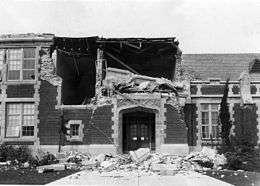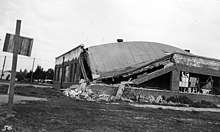1933 Long Beach earthquake
The 1933 Long Beach earthquake took place on March 10 at 5:54 P.M. PST south of downtown Los Angeles. The epicenter was offshore, southeast of Long Beach, California, on the Newport–Inglewood Fault. The earthquake had a magnitude estimated at 6.4 Mw, and a maximum Mercalli intensity of VIII (Severe). Damage to buildings was widespread throughout Southern California. 115 to 120 fatalities and an estimated forty million dollars' worth of property damage resulted. The majority of the fatalities resulted from people running out of buildings exposing themselves to the falling debris.
 Los Angeles | |
| UTC time | 1933-03-11 01:54:00 |
|---|---|
| ISC event | 905457 |
| USGS-ANSS | ComCat |
| Local date | March 10, 1933 |
| Local time | 5:54 P.M. PST[1] |
| Magnitude | 6.4 Mw [2] |
| Depth | 10 km (6.2 mi) [2] |
| Epicenter | 33.631°N 118.000°W [3] |
| Type | Strike-slip [4] |
| Areas affected | South Coast (California) United States |
| Total damage | $40 million [1] |
| Max. intensity | VIII (Severe) [1] |
| Casualties | 115–120 killed [1][5] |

_(14578209967).jpg)
Damage

The major damage occurred in the densely-populated city of Long Beach on the south-facing coast of Los Angeles County. However, the damage was also found to have extended to the industrial area south of downtown Los Angeles. The magnitude of the earthquake is considered to be medium but a significant amount of damage was left due to unfavorable geological conditions (landfill, water-soaked alluvium) combined with poorly constructed buildings. In Long Beach, buildings collapsed, water tanks fell through roofs, and houses were tossed off their foundations. School buildings were among the structures that incurred the most severe damage.[6] It was recognized that unreinforced masonry bearing walls is the reason for school buildings suffering so much damage in the wake of the earthquake.[7]
Aftermath
The earthquake highlighted the need for earthquake-resistant design for structures in California. Many school buildings were damaged, with more than 230 school buildings that either were destroyed, suffered major damage, or were judged unsafe to occupy. The California State Legislature passed the Field Act on April 10, 1933, mandating that school buildings must be earthquake-resistant. If the earthquake had occurred during school hours, the death toll would have been much higher.[8]
This earthquake prompted the government to play an active role in disaster relief. The government created The Reconstruction Finance Corporation, providing loans for the reconstruction of buildings that were affected during the natural disaster. The Bureau of Public Roads also took action to rebuild roads, highways, and bridges.[9] The economy of Long Beach was able to return to normal swiftly because of the rise of the aircraft industry. To support the World War II efforts, Long Beach created naval yards and increased the number of aircraft produced. This directly helped Long Beach repair and stabilize the economy after the disaster.[10]
Popular culture
The 1933 film Headline Shooter, uses newsreel footage of the Long Beach earthquake.
The earthquake plays a major part in the novel The Last Tycoon (1941), by F. Scott Fitzgerald. During the disruption caused by the quake, the hero, Monroe Stahr, meets Kathleen Moore, with whom he falls in love.
The earthquake is also included in John Fante's Ask the Dust (1939).
A radio newscast announces the aftermath of the earthquake in Season One, Episode Five of The Waltons.
This earthquake was mentioned by one of the guest characters, played by actor Ian Wolfe in Season Three, Episode One of Police Woman, who also mentions the 1971 San Fernando earthquake as the "Big One of '71".
Footage of the earthquake appeared in the film Encounters with Disaster, released in 1979 and produced by Sun Classic Pictures.
See also
References
- Stover, C. W.; Coffman, J. L. (1993), Seismicity of the United States, 1568–1989 (Revised) – U.S. Geological Survey Professional Paper 1527, United States Government Printing Office, pp. 78, 130, 131, archived from the original on 2019-04-13, retrieved 2016-10-29
- ISC (2015), ISC-GEM Global Instrumental Earthquake Catalogue (1900–2009), Version 2.0, International Seismological Centre, archived from the original on 2019-05-20, retrieved 2015-07-12
- USGS. "M6.4 – 7km WNW of Newport Beach, CA". United States Geological Survey. Archived from the original on 2018-03-16. Retrieved 2017-08-28.
- Hauksson, E.; Gross, S. (1991), "Source parameters of the 1933 Long Beach earthquake" (PDF), Bulletin of the Seismological Society of America, Seismological Society of America, 81 (1): 81, archived (PDF) from the original on 2016-04-23, retrieved 2016-04-09
- National Geophysical Data Center / World Data Service (NGDC/WDS) (1972), Significant Earthquake Database (Data Set), National Geophysical Data Center, NOAA, doi:10.7289/V5TD9V7K, archived from the original on 2017-07-21, retrieved 2016-04-09
-

- Green, Melvyn; Watson, Anne L. (1988). "Building Codes: Evaluating Buildings in Seismic Zones". APT Bulletin. 20 (2): 13–17. doi:10.2307/1494245. JSTOR 1494245.
- Alquist, A. E. (February 2007). "The Field Act and Public School Construction: A 2007 Perspective" (PDF). California Seismic Safety Commission. Archived (PDF) from the original on 3 November 2010. Retrieved 27 January 2011.
- Batten, Donna (2013), ""Natural Disasters." Gale Encyclopedia of Everyday Law", Gale Encyclopedia of Everyday Law, Gale, 2: 915–918, archived from the original on 2019-03-06, retrieved 2019-03-04
- Johnson, Daniel J (2003), Long Beach. Dictionary of American History 3rd ed., vol. 5, Charles Scribner's Sons, Charles Scribners & Sons; 3 edition, pp. 148, 149
External links
| Wikimedia Commons has media related to 1933 Long Beach earthquake. |
- USGS Historical Earthquakes – Long Beach, California – United States Geological Survey
- 75th Anniversary of the 1933 Long Beach Earthquake – California Department of Conservation
- National Information Service on Earthquake engineering page about Long Beach earthquake – National Information Service for Earthquake Engineering
- Catastrophe: A Bad One – Time
- Long Beach Earthquake: March 10, 1933 Cloyd E. Louis – Internet Archive
- The International Seismological Centre has a bibliography and/or authoritative data for this event.
- Image of workers clearing brick rubble from a sidewalk after the Long Beach earthquake, California, 1933. Los Angeles Times Photographic Archive (Collection 1429). UCLA Library Special Collections, Charles E. Young Research Library, University of California, Los Angeles.
- Watch Encounters with Disaster (1979) on the Internet Archive